仪表等级飞行员理论培训stage5219IFRFLIGHTPLAN.pptx
仪表等级飞行员理论培训
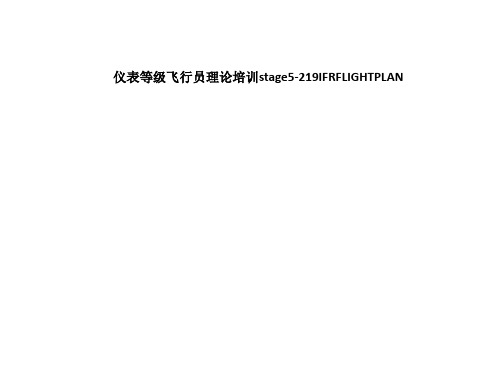
•“NW KRAFT”
14 CFR 91.103
仪表等级飞行员理论培训stage5-219IFRFLIGHTPLAN
Flight erview
• AIM: 5-1-1 to 5-1-13
• Before planning the flight details… take a broad look at your objective. Compare:
– Each pilot in command shall, before beginning a flight, become familiar with all available information concerning that flight. This information must include –
– (1) Complete the flight to the first airport of intended landing;
– (2) Except as provided in paragraph (b) of this section, fly from that airport to the alternate airport; and
–Distance with fuel –Weather with route –Terrain with aircraft performance –Goal and your proficiency –Is this trip really necessary?
仪表等级飞行员理论培训
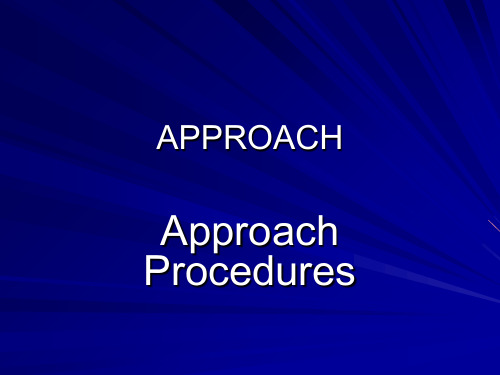
Initial Approach Fix
–Always labeled “IAF” on chart
Intermediate Approach Segment
Positions your aircraft for final descent to the airport
– For PA: at decision height/ altitude (DH/DA). – For NPA: either at a fix or timing.
Example of a missed approach
Preparing For The Approach
In planning, be familiar with the available IAPs… at Primary AND Alternate Airports. Nearing destination, a controller or ATIS tells you the expected IAP.
APPROACH
Approach Procedures
Safely Finding The Airport
Precision Approaches
Precision Approaches provide vertical guidance in addition to lateral guidance, most often through the use of an electronic glideslope. Precision Approaches include:
PT intersects final approach course inbound.
仪表等级飞行员理论培训stage5210APPROACHPROCEDURES
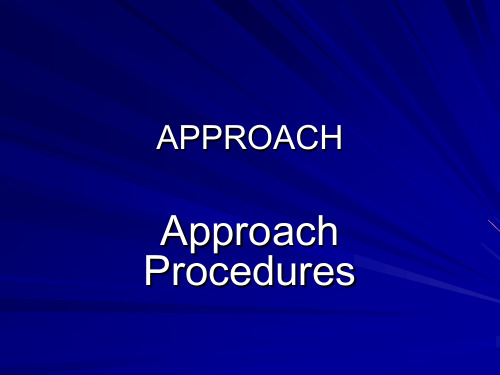
Approach Procedures
Safely Finding The Airport
Precision Approaches
Precision Approaches provide vertical guidance in addition to lateral guidance, most often through the use of an electronic glideslope. Precision Approaches include:
Final Segment of a VOR Approach (non-precision with FAP)
Missed Approach Segment
Navigate from MAP to missed approach holding point. Depicted on every approach
• NDB
• RNAV (GPS)
• ASR – Airport Surveillance Radar
• Localizer (front & back courses)
• LDA / SDF / RNAV
The United States Standard for Terminal Instrument Procedures (TERPS) is the approved criteria for formulating instrument approach procedures.
–Intermediate fix (IF) –Begins at point where you are
proceeding inbound to the final approach fix, properly aligned. –Not all approaches have an intermediate fix
仪表等级飞行员理论培训

理论培训的考核标准
ห้องสมุดไป่ตู้
仪表等级飞行员理论培训的考核 内容
仪表等级飞行员理论培训的考核 标准
添加标题
添加标题
添加标题
添加标题
仪表等级飞行员理论培训的考核 方式
仪表等级飞行员理论培训的考核 结果
P仪A表R等T级5飞行员理论培训的实
践应用
仪表等级飞行员在飞行中的实践应用
仪表等级飞行员的基本要求:具备相应的理论知识和技能,能够熟练操作飞行仪表和设备。
法与要求
理论培训的方法
制定培训计划:根据学员的实际 情况和需求,制定合理的培训计 划
教学方法:采用多种教学方法, 如讲解、演示、模拟训练等
添加标题
添加标题
添加标题
添加标题
教学内容:包括仪表等级飞行员 的理论知识、操作技能、安全知 识等
教学评估:对学员的学习情况进 行评估,及时调整教学计划和教 学方法
YOUR LOGO
仪表等级飞行员理 论培训
,a click to unlimited possibilities
汇报人:
时间:20XX-XX-XX
目录
01
添加标题
02
03
04
05
06
仪表等级飞行 员培训的重要 性
仪表等级飞行 员理论培训的 内容
仪表等级飞行 员理论培训的 方法与要求
仪表等级飞行 员理论培训的 实践应用
先进技术的应用:随着科技的不断进步,无人机、人工智能等先进技术的应用将为仪表等级飞行 员培训提供更多的实践机会和培训手段。
国际化趋势:随着全球化的加速,跨国航空公司的不断扩张将为仪表等级飞行员提供更多的就业 机会和国际化发展机遇。
(精品)仪表等级飞行员理论培训stage1-109RNAV-GPS1A

GPS Architecture
The GPS Positioning Concept
• Two principal pieces of information are required to determine a GPS position: ➢Position of each satellite ➢Range from the satellite to the user
What might a Flight Management System do for a pilot?
•Position •Airspeed •Groundspeed •Altitude hold •ETE / ETA •Heading •Course
• Ground Track • Fuel Burn
Once the Waypoint is set up in the receiver, the pilot simply treats it as though it were a real VOR
Programming the RNAV
Flight Management Systems: A Definition
• A minimum of four satellite signals are required to solve for an unaided, unique, position and time solution.
How Does GPS Work? Basic Function of GPS
Ground Antennas
GPS Architecture
User Element
• Consists of antennas and receiver/processors on board an aircraft, automobile, ship, cellular telephones and other new items like watches that provide positioning, velocity and precise timing to the user.
仪表等级飞行员理论培训

仪表等级飞行员理论培训概述仪表等级飞行员(Instrument Rating,简称IR)是指具备在飞行中依赖于仪表设备进行导航与飞行操作的能力。
仪表飞行是在无法直接依赖于目视条件进行飞行的情况下,通过仪器设备和导航工具来进行飞行。
仪表等级飞行员理论培训是获得仪表等级飞行资质的重要步骤,本文将详细介绍该理论培训的内容和要求。
仪表等级飞行员理论培训的目标仪表等级飞行员理论培训的主要目标是让飞行员具备通过仪器设备进行飞行操作和导航的能力。
具体目标包括:1.理解和应用仪表飞行规则(Instrument Flight Rules,简称IFR);2.掌握基本仪器的操作技巧和原理;3.熟悉仪表导航系统和导航工具的使用;4.理解仪表飞行中的气象条件和飞行特性;5.掌握仪表飞行中的通讯规范和流程;6.具备正规仪表进近和着陆的能力。
培训内容仪表等级飞行员理论培训包括多个科目和模块。
以下是主要的培训内容:1. 仪表飞行规则仪表飞行规则(IFR)是飞行员在飞行中依赖仪器设备进行导航和飞行操作的规则。
培训内容包括:•IFR的基本原则和要求;•IFR飞行计划和航路的规划;•IFR飞行中的大气条件和气象对飞行的影响;•IFR航空器的仪表配备和系统。
2. 仪表飞行的基本概念和技巧培训内容包括:•仪表飞行中的姿态和自动驾驶系统;•仪表飞行中的操纵技巧和飞行规程;•仪表飞行中的急进和急减技术。
3. 仪表飞行导航系统培训内容包括:•仪表飞行导航系统的原理和功能;•仪表飞行导航系统的操作和维修;•仪表飞行导航系统的故障排除。
4. 仪表飞行通讯培训内容包括:•仪表飞行通讯的标准和流程;•仪表飞行通讯的基本术语和短语;•仪表飞行通讯中的常见问题和解决方法。
5. 仪表飞行中的气象条件培训内容包括:•仪表飞行中的气象条件和飞行特性;•仪表飞行中的天气观察和飞行计划;•仪表飞行中的天气报告和预报。
6. 仪表进近和着陆培训内容包括:•仪表进近和着陆的基本概念和程序;•仪表进近和着陆的仪表要素和要求;•仪表进近和着陆的常见问题和处理方法。
仪表等级飞行员 理论培训
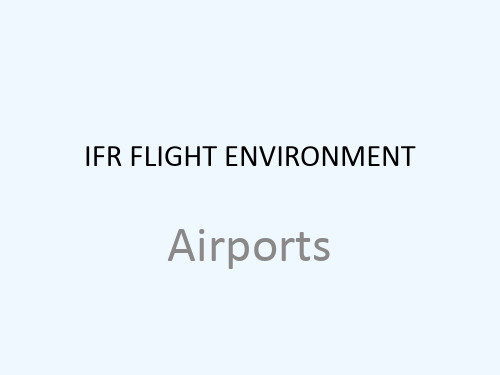
Airport Signs • Most airfield signs are standardized.
LAHSO
• Land and Hold Short Operations
– In effect at some controlled airports
• Could be at:
– Intersecting runway – Intersecting taxiway – Designated point on the runway
– Xs or simply blocked off
• Displaced Threshold
– Begin/end normal operations for takeoff and landing rollout, not fordisplaced threshold
• Determination of available landing distance (ALD)
Lighting Systems
• Approach Light System • Visual Glide Slope Indicators • Tri Color VSI • Runway Lighting • Airport Beacon and Obstruction Lights
intending to land.
Causes of Runway Incursion
仪表等级飞行员理论培训
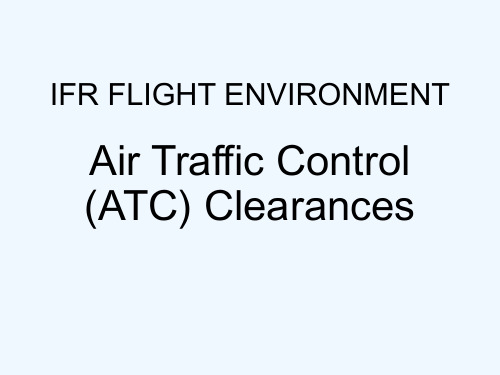
• “At pilot’s discretion”: you may choose when to start climb and intermediate level offs
• Gentle turns climbing in VMC • Rely on YOUR “see and avoid”
• Standard Instrument Departures – SIDs
– Created for ATC traffic management purposes – Terminate at a NAVAID/FIX in enroute environment – ATC assumes you have charts
• Short range clearance –Fix within or just outside departure terminal area –Typically puts you where radar can see you
Departure Procedure
• Published textual or graphic departure instructions
Holding Instructions
• ATC will issue complete holding instructions with clearance limit /delay unless it’s charted.
• When the holding pattern is charted, the controller may omit everything except the charted holding direction and “as published”
《仪表飞行课程》课件

目 录
• 仪表飞行简介 • 仪表飞行基础知识 • 仪表飞行技能训练 • 仪表飞行案例分析 • 仪表飞行未来发展
01
仪表飞行简介
仪表飞行的定义
01
仪表飞行是指飞行员在无法目视 外部参照物的情况下,依靠机载 仪表和导航设备完成飞行任务。
02
仪表飞行要求飞行员具备高超的 飞行技巧和扎实的航空理论知识 ,以确保安全、准确地完成飞行 任务。
案例一
某航空公司航班在恶劣天气下的仪表飞行
案例二
某飞行员在失去方向感时的紧急处理
案例三
某飞机在仪表飞行中遭遇机械故障的应对措施
案例分析:仪表飞行事故原因
原因一
飞行员对仪表的过度依赖,忽视目视飞行
原因二
仪表故障或误差导致飞行指引失灵
原因三
紧急情况下,飞行员应对措施不当或失误
案例总结与经验教训
01ห้องสมุดไป่ตู้
02
教授飞行员在紧急情况下应遵循 的程序,如失速、失去动力、机
械故障等。
紧急决策
教授飞行员在紧急情况下如何快 速做出正确决策,包括选择合适 的紧急降落地点、采取应急措施
等。
紧急沟通
教授飞行员在紧急情况下如何与 其他飞机或地面控制中心进行有 效的沟通,确保得到及时的援助
和支持。
04
仪表飞行案例分析
仪表飞行实际案例介绍
发挥重要作用,实现快速、准确的货物配送。
航空医疗救援
02
借助仪表飞行的精准导航和快速响应能力,未来的航空医疗救
援将更加及时、高效,挽救更多生命。
城市空中交通
03
随着城市空中交通的发展,未来的仪表飞行将为城市出行提供
仪表等级飞行员理论培训stage5-219IFRFLIGHTPLAN
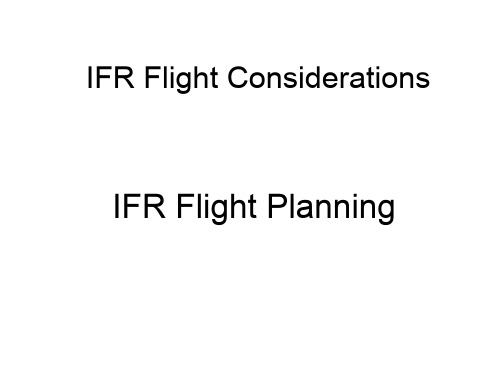
– (i) For aircraft other than helicopters. For at least 1 hour before and for 1 hour after the estimated time of arrival, the ceiling will be at least 2,000 feet above the airport elevation and the visibility will be at least 3 statute miles.
– (c) IFR alternate airport weather minima.
– Unless otherwise authorized by the Administrator, no person may include an alternate airport in an IFR flight plan unless appropriate weather reports or weather forecasts, or a combination of them, indicate that, at the estimated time of arrival at the alternate airport, the ceiling and visibility at that airport will be at or above the following weather minima:
– at ETA at alternate
仪表着陆系统培训课件

仪表着陆系统培训课件xx年xx月xx日contents •仪表着陆系统概述•仪表着陆系统的工作原理•仪表着陆系统的安装与调试•仪表着陆系统的使用与维护•仪表着陆系统的应用场景与发展趋势•仪表着陆系统培训课件总结与展望目录01仪表着陆系统概述仪表着陆系统的定义01仪表着陆系统(Instrument Landing System,ILS)是一种空中交通管制系统,它为飞行员提供精确的进近和着陆引导,确保飞机在机场的安全降落。
02该系统包括一套精密的无线电导航设备和机场监视雷达,以及与飞机上的仪表和导航设备相配合的通信和控制设备。
03它利用无线电信号和机场监视雷达的扫描信号来提供飞行员的进近和着陆指引,帮助飞行员在恶劣天气条件下或夜间等复杂环境中进行安全着陆。
仪表着陆系统由地面设备和机载设备组成。
地面设备包括一套精密的无线电导航设备和机场监视雷达。
无线电导航设备发射无线电信号,为飞行员提供进近和着陆指引;机场监视雷达则扫描机场空域,提供飞机位置和速度等信息。
机载设备包括飞机上的仪表和导航设备,如自动定向仪(ADF)、测距器(DME)和飞行指引仪(FMS)等。
这些设备接收地面设备和机场监视雷达的信号,为飞行员提供准确的进近和着陆指引。
仪表着陆系统的组成根据信号覆盖范围,仪表着陆系统可分为Ⅰ类、Ⅱ类和Ⅲ类。
Ⅱ类仪表着陆系统提供部分覆盖,适用于良好天气条件和白天运行。
它可以在一定范围内提供进近和着陆指引,但飞行员需要目视参考以完成着陆。
Ⅲ类仪表着陆系统是最简单的仪表着陆系统,只提供非强制性的进近指引,适用于低能见度下的着陆。
它不提供全向覆盖,飞行员需要根据目视参考或其他导航方式完成着陆。
Ⅰ类仪表着陆系统提供全向覆盖,适用于所有天气条件和机场运行条件。
它是最完善的仪表着陆系统,可以引导飞机在任何天气条件下安全着陆。
仪表着陆系统的分类02仪表着陆系统的工作原理无线电导航是利用无线电波的传播特性,确定飞行器的导航参数(如位置、速度、航向等)的一种导航方式。
表格模板-仪表等级飞行员理论培训stage5219IFRFLIGHTP
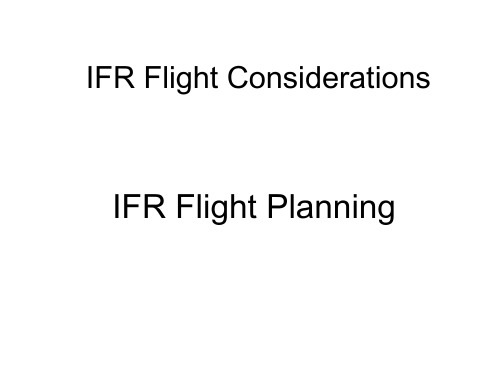
• (b) Paragraph (a)(2) of this section does not apply if:
– (1) Part 97 of this chapter prescribes a standard instrument approach procedure to, or a special instrument approach procedure has been issued by the administrator to the operator for, the first airport of intended landing; and
• (b) For any flight, runway lengths at airports of intended use, and the following takeoff and landing distance information:
•“NW KRAFT”
14 CFR 91.103
• Alternate is NOT needed when: – first airport has IAP AND
–Distance with fuel –Weather with route –Terrain with aircraft performance –Goal and your proficiency –Is this trip really necessary?
• § 91.103 Preflight action.
14 CFR 91.167
• Fuel Requirements for Flight in IFR Conditions: – to first airport of intended landing – to alternate airport (if required) – 45 minutes at normal cruising speed
仪表等级飞行员理论培训stage5-219IFRFLIGHTPLAN

• § 91.103 Preflight action.
IFR Flight Considerations
IFR Flight Planning
Flight Overview
• AIM: 5-1-1 to 5-1-13
• Before planning the flight details… take a broad look at your objective. Compare:
• Alternate is NOT needed when: – first airport has IAP AND
– 1 - 2 - 3 rule forecast wx – +/-1 hour ETA – At least 2,000’ceiling – At least 3 SM visibility
– (i) For aircraft other than helicopters: The alternate airport minima specified in that procedure, or if none are specified the following standard approach minima:
• Fuel Requirements for Flight in IFR Conditions: – to first airport of intended landing – to alternate airport (if required) – 45 minutes at normal cruising speed
仪表飞行课程PPT课件

.
16
1.3.4 高度表的改进(编码高度表)
空域系统中如果只有飞行员有飞机高度指示是远远不够的, 地面上的空中交通管制员必须清楚地知道飞机的高度。为了 提供这一信息,通常为飞机配备编码高度计。当 ATC 应答机 调定在C 模式,编码高度表提供一系列识别飞机所在飞行高 度的脉冲信号给应答机(以100 英尺开始递增)。
鼓形机载高度计简图,在
.
左下角和右下角可见科尔 斯曼窗口
8
图示展示了一个具有三根指针的灵敏航空高度计显示当前高 度为10,180英尺
10 000 ft
100 ft
1000 ft
29.9mmHg
.
9
1.3.1.3 机械式误差
1.3.1.2 高度表的误差
气压式高度表的设计是符合标准 状况下气压的标准变化规律的, 但是大多数飞行都会由于非标准 的飞行条件而产生误差,飞行员 必须对这些指示进行相应的修正。 其误差有两种类型:机械式和固 有式。
飞行员在起飞前检查时应确定高度表的工作状况,将气压刻度盘调 到当地的修正气压值。此时高度表应该指示机场的实际标高。如果 高度表的指示偏离实际标高超过75 英尺,则仪表应该送到指定的 仪表维修站来重新进行校准。不同的外界温度以及不同的气压也会 造成高度表的显示不准确。
1.3.1.4 固有式误差
当在空中的飞机周围温度高于标准大气时,空气密度相对较小,每
面的实际高度低于在标准温度条件下指示50.00 英尺的高度,因此飞
10
机的实际高度也就比相对较热的标准温度条件下的高度低。
.
11
1.3.1.5 寒冷天气条件下高度表的误差
在国际标准大气(ISA)条件下,正确校准后的气压式高度表指示的 是在平均海平面(MSL)之上的真实高度。非标准气压条件下应使用 当地修正气压来进行校准。如果当时温度高于ISA,真实高度将高于 指示高度,如果当时温度低于ISA,真实高度将低于指示高度。当温 度低于ISA 温度时,真实高度与指示高度之间的不一致可能会导致飞 机的越障高度不够。英文的口诀叫作:High to Low, warm to cold, watch below!
- 1、下载文档前请自行甄别文档内容的完整性,平台不提供额外的编辑、内容补充、找答案等附加服务。
- 2、"仅部分预览"的文档,不可在线预览部分如存在完整性等问题,可反馈申请退款(可完整预览的文档不适用该条件!)。
- 3、如文档侵犯您的权益,请联系客服反馈,我们会尽快为您处理(人工客服工作时间:9:00-18:30)。
• § 91.103 Preflight action.
• Alternate is NOT needed when: – first airport has IAP AND
• §91.167 Fuel requirements for flight in IFR conditions
. • (a) No person may operate a civil aircraft in IFR conditions
unless it carries enough fuel (considering weather reports and forecasts and weather conditions) to –
14 CFR 91.167
• Fuel Requirements for Flight in IFR Conditions: – to first airport of intended landing – to alternate airport (if required) – 45 minutes at normal cruising speed
• Preflight Action: NW KRAFT • (a) For a flight under IFR, pilot should know:
• N- Notams (all available info concerning flight) • W- weather reports and forecasts • K - known traffic delays • R –runway lengths • A- alternatives available • F -fuel requirements • T –Take Off/Landing Distance info, Section (b)
• (a) For a flight under IFR or a flight not in the vicinity of an airport, weather reports and forecasts, fuel requirements, alternatives available if the planned flight cannot be completed, and any known traffic delays of which the pilot in command has been advised by ATC;
– (1) Complete the flight to the first airport of intended landing;
– (2) Except as provided in paragraph (b) of this section, fly from that airport to the alternate airport; and
• (b) For any flight, runway lengths at airports of intended use, and the following takeoff and landing distance information:
•“NW KRAFT”
14 CFR 91.103
– Each pilot in command shall, before beginning a flight, become familiar with all available information concerning that flight. This information must include –
– (2) Appropriate weather reports or weather forecasts, or a combination of them, indicate the following:
• (i) For at least 1 hour before and for 1 hour after the estimated time of arrival, the ceiling will be at least 2,000 feet above the airport elevation and the visibility will be at least 3 statute miles.
– (3) Fly after that for 45 minutes at normal cruising speed.
• (b) Paragraph (a)(2) of this section does not apply if:
– (1) Part 97 of this chapter prescribes a standard instrument approach procedure to, or a special instrument approach procedure has been issued by the administrator to the operator for, the first airport of intended landing; and
IR Flight Planning
Flight Overview
• AIM: 5-1-1 to 5-1-13
• Before planning the flight details… take a broad look at your objective. Compare:
